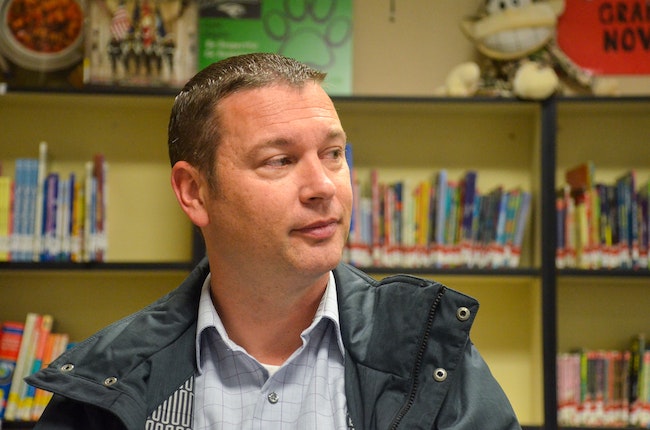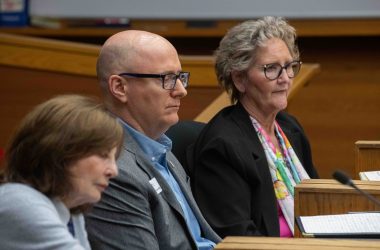
Scott Stenlund, Washington Elementary School principal (Rachel Alexander/Salem Reporter)
Washington Elementary School has countered disappointing student test performance across Salem schools, nearly tripling in the past two years the percentage of students on track in math with similar gains in reading.
Under principal Scott Stenlund, the school of about 400 students, just south of Silverton Road in the Lansing neighborhood, has improved more than almost any other Oregon elementary school in the past two years.
That success against peers across the state is more significant because of the school’s demographics: nine in ten students qualify for free lunch, and six in ten aren’t native English speakers.
“Even in the midst of what I feel is sometimes chaos, so many kids, they are learning,” said third-grade teacher Alyssa McKay, tearing up as she spoke about what the results meant for Washington’s teachers. “It was so amazing to see that hard work pay off.”
[ Help build Salem Reporter and local news – SUBSCRIBE ]
Three years ago, the school was one of the lowest-performing in Salem-Keizer. Just one in five students read at their own grade level, and one in ten performed to the state standard for math.
It’s still far from a high-achieving school. With about one third of students reading at grade level and one in four hitting math benchmarks, Washington educators have work ahead.
But compared to where the school was in 2017, the progress spearheaded by Stenlund strikes the school’s educators as remarkable.
Just 16% of Oregon schools improved both reading and math scores last year, state data shows. Only 15 other schools in the state improved as much as Washington.
“It’s a huge celebration,” said Sandie Price, the district’s elementary school director who oversees Washington, along with 13 local schools.
Stenlund came to the school in the fall of 2016, fresh off five years as principal at Lamb Elementary.
His first spring at the school, just one in 10 Washington students could do math as expected by the state, and only one in five read at grade level, making the school one of the lowest-performing in the district.
That environment was exactly where he wanted to be. He’s the son of two educators from Woodburn, is bilingual in Spanish and wanted to be somewhere he could make an impact.
“Definitely teaching’s in my blood,” he said. “I like the challenge too. Sometimes you bite off more than you can chew.”
Since coming to Washington, Stenlund has shored up the school’s systems for helping kids in small groups catch up on math and reading, and focused on teaching the teachers to keep kids engaged and learning.
“I treat my teachers as experts,” he said.
 Teacher Alyssa McKay plans math lessons during Washington Elementary School’s weekly meeting before students arrive. (Rachel Alexander/Salem Reporter)
Teacher Alyssa McKay plans math lessons during Washington Elementary School’s weekly meeting before students arrive. (Rachel Alexander/Salem Reporter)
The systems Stenlund has in place aren’t radically different from what other local elementary schools are doing. Washington teachers use the same curriculum and have weekly meetings to discuss lessons and share teaching techniques, something that happens districtwide.
But at Washington, the process feels more focused and systematic as Stenlund has slowly added elements to help teachers teach and students learn.
When you walk into a classroom, “you see kids writing, speaking or actually doing work, not just sitting and listening to a teacher doing all the work,” Price said.
It’s clearer and more consistent than at other schools.
“That’s Scott’s instructional leadership. That’s his expertise in language development and good strategies,” Price said.
Demographically, Washington looks like many of Salem-Keizer’s challenged elementary schools. It’s one of 22 in the district with a federal designation giving the school extra money because nearly all of its students come from low-income families.
Such schools generally struggle to post good test results compared with wealthier schools in Salem-Keizer and in Portland and Beaverton.
In Salem-Keizer and at Washington, learning gaps are evident when students enter kindergarten.
Being a teacher at the school means playing catch-up: a kid who’s behind in coming into kindergarten will exit fifth grade still behind even if they learn a year’s worth of English and math every year.
On average, Washington kindergarteners recognize just two letter sounds and six uppercase letters when starting school. That’s less than half the state average, and far lower than Salem-Keizer’s higher income elementary schools, where students may know half the alphabet.
That means the school’s successes have broad implications across the district – what’s working at Washington should work elsewhere.
 Kaylyn Siobal helps her fifth-grade students with a math problem in class at Washington Elementary School on Oct. 21, 2019 (Rachel Alexander/Salem Reporter)
Kaylyn Siobal helps her fifth-grade students with a math problem in class at Washington Elementary School on Oct. 21, 2019 (Rachel Alexander/Salem Reporter)
On a Monday morning in October, fifth-grade teacher Kaylyn Siobal walked around her class writing on a clipboard as students worked on a math problem.
She’d just started a new unit, reading a question about the area of a planned shopping mall expansion to her students before turning them loose to work out an answer on their own.
Siobal’s clipboard noted how students were approaching the question. Some were adding numbers instead of multiplying them, or struggling to proceed.
Siobal said taking notes as students work helps her see common threads and decide which students to have share their thinking with the group. It’s more active than simply waiting to see who understood the question or got the right answer once work is turned in.
“I want to make sure I know what students are doing,” she said.
Each student has a small flipbook on their desk with red, yellow, green “response cards,” another way Siobal checks in. Red means they’re working through something, and green means they’ve finished a task. Yellow means they’re confused or need help.
It gives her a quick way to see who needs more time or gauge if the class as a whole is confused without asking each student individually and taking up precious class time.
Stenlund said that’s one example of the culture he nurtures at Washington. He seeks clear expectations for students and teachers using specific tactics so students are focused, engaged and know what they’re supposed to be doing.
He’s used a book called “Teach Like a Champion,” which emphasizes focusing on specifics instead of general goals like “set high expectations.”
Doug Lemov, the author, writes about small things that go overlooked, like practicing with students to efficiently pass out papers and other class materials, challenging them to beat their time.
It sounds mundane, but given how often teachers pass out and collect materials, a class that can get everything done in 20 seconds can gain more learning time in a day than a class that takes a minute or more each time.
 Washington Elementary School Principal Scott Stenlund talks with teacher Rebecca Hodges during the school’s weekly planning meeting on Oct. 23, 2019 (Rachel Alexander/Salem Reporter)
Washington Elementary School Principal Scott Stenlund talks with teacher Rebecca Hodges during the school’s weekly planning meeting on Oct. 23, 2019 (Rachel Alexander/Salem Reporter)
At Washington, Stenlund observes teachers in class to see what might be helpful, then uses the book to zero in on things to teach his staff. He’s emphasized a few tactics.
One is “cold calling,” where a teacher picks a student to answer a question instead of calling on someone with a raised hand. It’s a way to check understanding for everyone, not just the handful of students eager to answer.
Another is teaching kids how to pay attention in class with an acronym, SLANT, which stands for “sit up, listen, ask and answer questions, nod your head, track the speaker.” The goal is to set those expectations early in the year so teachers can simply say “Slant!” and the students will focus.
To start the year, Stenlund surveyed his teachers on which techniques they were using in class and had them set goals for trying new tactics or incorporating others more regularly.
It’s part of a school focus on growth. Teachers are always trying to better themselves as professionals and instill in students that they can learn new skills too.
“If we’re growing, then our students are going to grow automatically,” Stenlund said.
Teachers say it’s helped them translate theoretical conversations about teaching into useful practices.
“Everything when you’re learning to teach is in theory,” said Megan Smatlan, a second-grade teacher who’s been at Washington for seven years.
When one teacher develops a system that works well, sharing with the entire teaching staff is encouraged. Smatlan created a system for translating phonics lessons onto posters that’s spread to other teachers.
McKay helped develop a spreadsheet for tracking student’s scores on tests in reading so teachers can readily see who needs help.
 Washington students are encouraged to submit jokes to be read during the school’s morning announcements (Rachel Alexander/Salem Reporter)
Washington students are encouraged to submit jokes to be read during the school’s morning announcements (Rachel Alexander/Salem Reporter)
It’s not all serious. Stenlund knows school culture matters, and he keeps things lively by reading jokes on the morning announcements. (School employees collectively rebelled against the bad puns and insisted he start taking suggestions from students.)
His teachers are comfortable teasing him during weekly meetings, and sometimes push him to make up educational raps to go along with lessons.
The school has a club for students who want to spend recess burning off extra energy by running laps, and their progress and high scores are tracked on a bulletin board in the main hallway.
Stenlund has also worked to make small group help in reading and math as effective as possible for students, using slight tweaks over radical changes.
He also got permission from the district for a later start time on Wednesdays so teachers can plan lessons before they’re dealing with 32 or so kids.
“Teachers need to be fresh for this hard work,” he said.
He’s also paid classroom aides to come to those meetings so they know what students are working on and understand the thinking behind lessons they use in helping individual students.
 Fifth-grade teacher Ashley Marshall talks a student through a math problem in class on Oct. 21, 2019 (Rachel Alexander/Salem Reporter)
Fifth-grade teacher Ashley Marshall talks a student through a math problem in class on Oct. 21, 2019 (Rachel Alexander/Salem Reporter)
Stenlund also has tinkered with “intervention” time – a feature in every elementary school where students split into smaller groups based on their skill level to get particular help.
Stenlund has built up a collection of materials that provide several ways to help kids, aiming to help students with very specific reading struggles, especially before third grade.
A student who hasn’t mastered phonics, for instance, will spend six weeks in a small group with a teacher or classroom aide working through one curriculum. A student still not progressing gets a shot at another curriculum and another approach to the reading challenge.
Teachers said they’re seeing an impact. McKay said fewer of her students come into third grade reading at a first or second grade level, which makes her job easier.
“The growth that I’ve seen in reading is greater than I’ve ever seen before,” she said.
Reporter Rachel Alexander: [email protected] or 503-575-1241.

Rachel Alexander is Salem Reporter’s managing editor. She joined Salem Reporter when it was founded in 2018 and covers city news, education, nonprofits and a little bit of everything else. She’s been a journalist in Oregon and Washington for a decade. Outside of work, she’s a skater and board member with Salem’s Cherry City Roller Derby and can often be found with her nose buried in a book.









